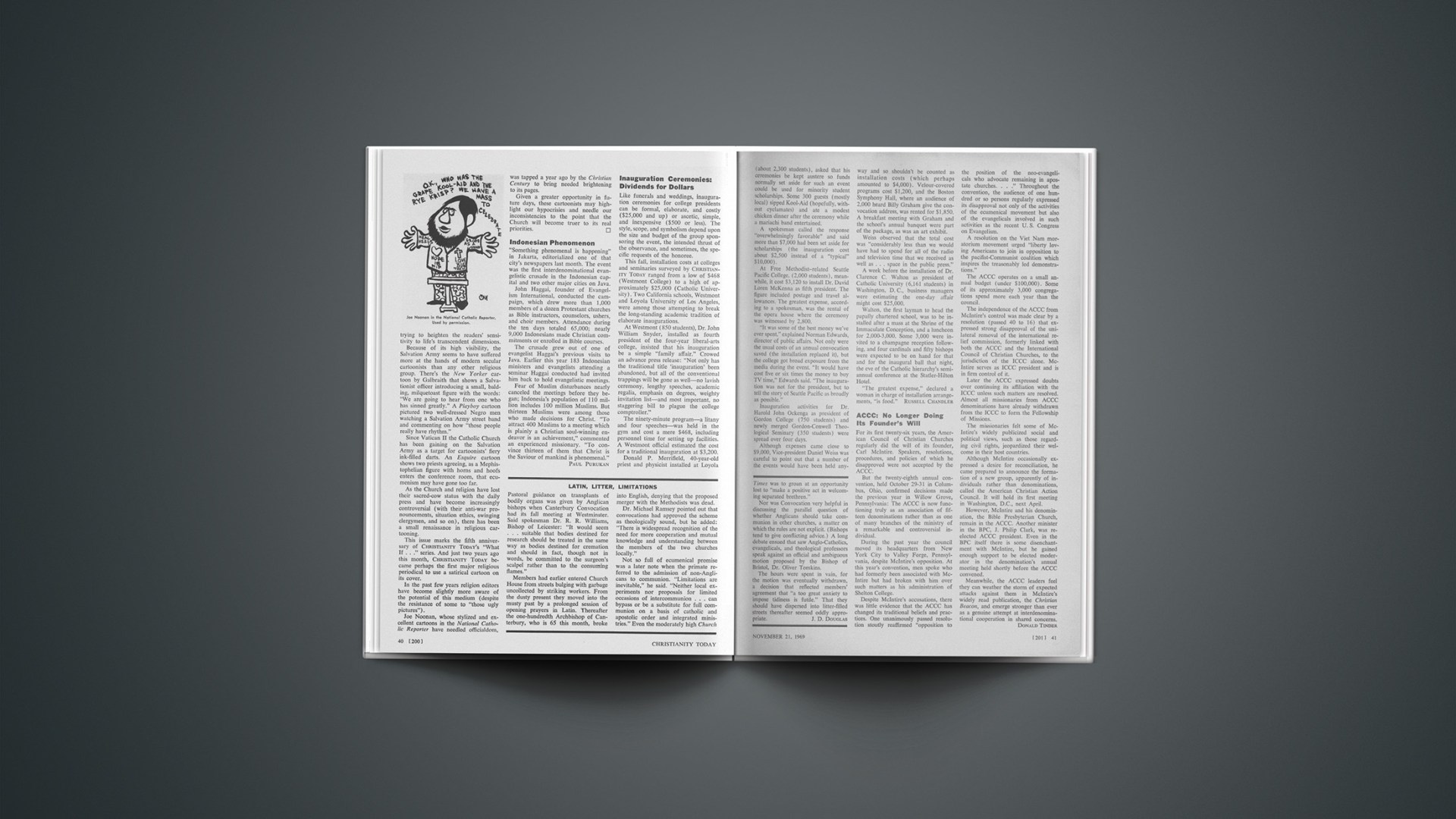Like funerals and weddings, inauguration ceremonies for college presidents can be formal, elaborate, and costly ($25,000 and up) or ascetic, simple, and inexpensive ($500 or less). The style, scope, and symbolism depend upon the size and budget of the group sponsoring the event, the intended thrust of the observance, and sometimes, the specific requests of the honoree.
This fall, installation costs at colleges and seminaries surveyed by CHRISTIANITY TODAY ranged from a low of $468 (Westmont College) to a high of approximately $25,000 (Catholic University). Two California schools, Westmont and Loyola University of Los Angeles, were among those attempting to break the long-standing academic tradition of elaborate inaugurations.
At Westmont (850 students), Dr. John William Snyder, installed as fourth president of the four-year liberal-arts college, insisted that his inauguration be a simple “family affair.” Crowed an advance press release: “Not only has the traditional title ‘inauguration’ been abandoned, but all of the conventional trappings will be gone as well—no lavish ceremony, lengthy speeches, academic regalia, emphasis on degrees, weighty invitation list—and most important, no staggering bill to plague the college comptroller.”
The ninety-minute program—a litany and four speeches—was held in the gym and cost a mere $468, including personnel time for setting up facilities. A Westmont official estimated the cost for a traditional inauguration at $3,200.Donald P. Merrifield, 40-year-old priest and physicist installed at Loyola (about 2,300 students), asked that his ceremonies be kept austere so funds normally set aside for such an event could be used for minority student scholarships. Some 300 guests (mostly local) sipped Kool-Aid (hopefully, without cyclamates) and ate a modest chicken dinner after the ceremony while a mariachi band entertained.
A spokesman called the response “overwhelmingly favorable” and said more than $7,000 had been set aside for scholarships (the inauguration cost about $2,500 instead of a “typical” $10,000).
At Free Methodist—related Seattle Pacific College, (2,000 students), meanwhile, it cost $3,120 to install Dr. David Loren McKenna as fifth president. The figure included postage and travel allowances. The greatest expense, according to a spokesman, was the rental of the opera house where the ceremony was witnessed by 2,800.
“It was some of the best money we’ve ever spent,” explained Norman Edwards, director of public affairs. Not only were the usual costs of an annual convocation saved (the installation replaced it), but the college got broad exposure from the media during the event. “It would have cost five or six times the money to buy TV time,” Edwards said. “The inauguration was not for the president, but to tell the story of Seattle Pacific as broadly as possible.”
Inauguration activities for Dr. Harold John Ockenga as president of Gordon College (750 students) and newly merged Gordon-Conwell Theological Seminary (350 students) were spread over four days.
Although expenses came close to $9,000, Vice-president Daniel Weiss was careful to point out that a number of the events would have been held anyway and so shouldn’t be counted as installation costs (which perhaps amounted to $4,000). Velour-covered programs cost $1,200, and the Boston Symphony Hall, where an audience of 2,000 heard Billy Graham give the convocation address, was rented for $1,850. A breakfast meeting with Graham and the school’s annual banquet were part of the package, as was an art exhibit.
Weiss observed that the total cost was “considerably less than we would have had to spend for all of the radio and television time that we received as well as … space in the public press.”
A week before the installation of Dr. Clarence C. Walton as president of Catholic University (6,161 students) in Washington, D. C., business managers were estimating the one-day affair might cost $25,000.
Walton, the first layman to head the papally chartered school, was to be installed after a mass at the Shrine of the Immaculate Conception, and a luncheon for 2,000–3,000. Some 3,000 were invited to a champagne reception following, and four cardinals and fifty bishops were expected to be on hand for that and for the inaugural ball that night, the eve of the Catholic hierarchy’s semi-annual conference at the Statler-Hilton Hotel.
“The greatest expense,” declared a woman in charge of installation arrangements, “is food.”
RUSSELL CHANDLER










